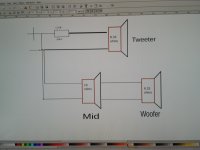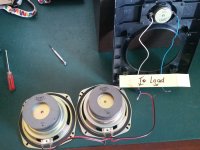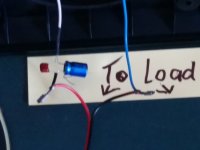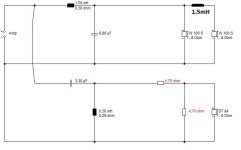Both tweeters are 8.3 ohms, I will ad a circuit diagram of the actual lay out.All of this only makes sense if the tweeters are fully functional.
BTW guy, just to remind you all that I'm a complete nub regarding speaker, inductors and frequencies, and the terminology that goes with it, so you may have to dumb it down for me some what Lol.
Hey there ...
Surely it must be remembered that this speaker (pair) is of a very low cost project.
I have a pair of Sony 'towers' that use 2x 6inch 8 ohm woofers. (a future tweaking project)
The woofers are a very similar silver painted paper cone > these woofers are very decent.
In fact all Sony woofers I have encountered are really quite good.
It would seem that it's the Mid & Tweeter here (+ single caps.) that are of concern, especially
the tweeter seeming to be a dull/low output super tweeter.
Unless I have misunderstood something, these speakers are 3 way, so I don't understand why
members keep posting > 2 way crossover networks ?
If it were me, due to surface mount drivers, I would simply buy a nice cheap dome replacement tweeter
and an 'off the shelf' crossover of roughly 1K & 5Khz, install and assess the existing midrange.
For this class of speaker & project, there are many suitable replacement parts at low cost.
PS.
'Off the shelf' crossovers are NOT all bad.
Surely it must be remembered that this speaker (pair) is of a very low cost project.
I have a pair of Sony 'towers' that use 2x 6inch 8 ohm woofers. (a future tweaking project)
The woofers are a very similar silver painted paper cone > these woofers are very decent.
In fact all Sony woofers I have encountered are really quite good.
It would seem that it's the Mid & Tweeter here (+ single caps.) that are of concern, especially
the tweeter seeming to be a dull/low output super tweeter.
Unless I have misunderstood something, these speakers are 3 way, so I don't understand why
members keep posting > 2 way crossover networks ?
If it were me, due to surface mount drivers, I would simply buy a nice cheap dome replacement tweeter
and an 'off the shelf' crossover of roughly 1K & 5Khz, install and assess the existing midrange.
For this class of speaker & project, there are many suitable replacement parts at low cost.
PS.
'Off the shelf' crossovers are NOT all bad.
We have a set of sealed Sony 2-way in one of our shop spaces where I work. Some cabinet filling material and low levels make them not so bad.
I had a Sony 3-way set I purchased new in 1983 with my paper route money. Dumped them almost twenty years later after building my own. Things have gotten much better since then…
I had a Sony 3-way set I purchased new in 1983 with my paper route money. Dumped them almost twenty years later after building my own. Things have gotten much better since then…
I think that upon further investigation > you will find that only one capacitor is used for the tweeterhere's the circuit.
and the other capacitor is used for the midrange. Otherwise, something is definitely wrong.
What you have shown there is possible, just unusual. I can see why Mister Audio is thinking that way.
Add 1uF in parallel with those two capacitors and listen to the difference.here's the circuit.
Bypassing bipolar electrolytic capacitors bypasses its higher ESR as well. And you can hear it at higher frequencies where the bypass cap works. The bipolar electrolytic capacitor consists of two back-to-back connected polarized capacitors.I wouldn't bother with this.
I'm not aware of any AB test proving the bypass cap theory.
The problem here is that it lacks a bit of mids and highs, so I suggest a simple trial with a lower cutoff frequency by adding 1uF to 1.8+0.33.
Last edited:
Bypassing is a common practice at radio frequencies.
| In this example.. Red=(10uF+0Ω) Blue=(10uF+1Ω) Yellow=(9uF+1Ω)//(1uF+0Ω) |
Last edited:
Good Heavens, @AllenB, I am a Radio Frequency Engineer myself! I worked up to 45 MHz. But thought I'd let discussions of bypasssing capacitors drift into the wind since it is not usually a problem at Audio Frequencies.
Anyway, here's my (simplified) solution to this wretched but interesting Sony SS-S9 problem:

Maybe one might need to fiddle around with the precise resistor values, but I think it will be an improvement on a loudspeaker clearly designed for low cost rather than high quality. 🙂
Anyway, here's my (simplified) solution to this wretched but interesting Sony SS-S9 problem:
Maybe one might need to fiddle around with the precise resistor values, but I think it will be an improvement on a loudspeaker clearly designed for low cost rather than high quality. 🙂
This is getting unnecessarily complicated. No one can make a meaningful crossover with unknown speakers. Get two 3.3uF capacitors of any kind (polyester, polypropylene, polycarbonate) as long as they are not electrolytic and put them in place of the two factory ones. Or 2.2+1uF. There will be a little more mids and highs in the sound.
Where is 'by the fanatics for the fanatics' spirit?
Simply doubling the cap to tweeter may lower the crossover frequency, hence produce more highs, but it may sound more distorted as tiny tweeter will be strugling.
Simply doubling the cap to tweeter may lower the crossover frequency, hence produce more highs, but it may sound more distorted as tiny tweeter will be strugling.
Yeah...you are right. Not to mention wrong and misleading title 🙂
Ideally he should just leave it as it is. And invite them for dinner.
Ideally he should just leave it as it is. And invite them for dinner.
I believe many have gone down a rabbit-hole. The SS-S9 is not a 3-way speaker. It's a 2-way. The 6" woofers are identical, one has an inverted dust cap to make it look subwooferish. They sound okay although the cabinet is probably too small for the drivers.
Throw in a little damping, replace the cap. They should brighten up a little.
Throw in a little damping, replace the cap. They should brighten up a little.
- Home
- Loudspeakers
- Multi-Way
- Advice on Sony 3 way speakers without crossover



